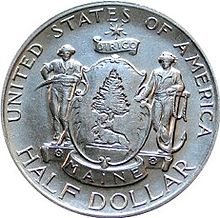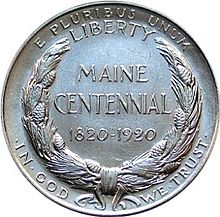United States | |
| Value | 50 cents or 0.50 US dollars |
|---|---|
| Mass | 12.5 g |
| Diameter | 30.61 mm (1.20 in) |
| Thickness | 2.15 mm (0.08 in) |
| Edge | Reeded |
| Composition |
|
| Silver | 0.36169 troy oz |
| Years of minting | 1920 |
| Mintage | 50,028 including 28 pieces for the Assay Commission |
| Mint marks | None, all pieces struck at the Philadelphia Mint without mint mark |
| Obverse | |
 | |
| Design | Arms of Maine |
| Designer | Anthony de Francisci, based on sketches by Harry Cochrane |
| Design date | 1920 |
| Reverse | |
 | |
| Design | Pine wreath |
| Designer | Anthony de Francisci, based on sketches by Harry Cochrane |
| Design date | 1920 |
The Maine Centennial half dollar is a commemorative coin struck in 1920 by the United States Bureau of the Mint, in honor of the anniversary of Maine's admission to the Union on March 15, 1820. It was sculpted by Anthony de Francisci, following sketches by artist Harry Cochrane, from Monmouth, Maine.
Officials in Maine wanted a commemorative half dollar to circulate as an advertisement for the centennial of the state's admission to the Union, and of the planned celebrations. A bill to allow such a coin passed Congress without opposition, but then the state's centennial commission decided to sell the coins for $1, double the face value. The Commission of Fine Arts disliked the proposed design, and urged changes, but Maine officials insisted, and de Francisci converted the sketches to plaster models, from which coinage dies could be made.
Fifty thousand pieces, half the authorized mintage, were struck for release to the public. They were issued too late to be sold at the centennial celebrations in Portland, but eventually the coins were all sold, though relatively few went to coin collectors. Today they list for hundreds to thousands of dollars, depending on condition.